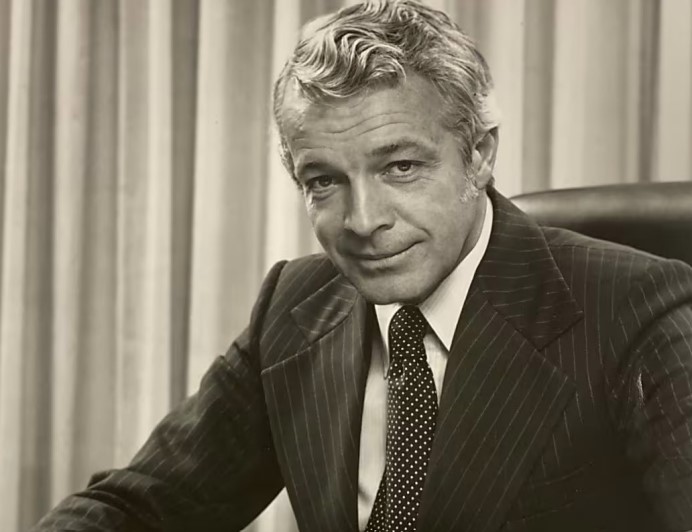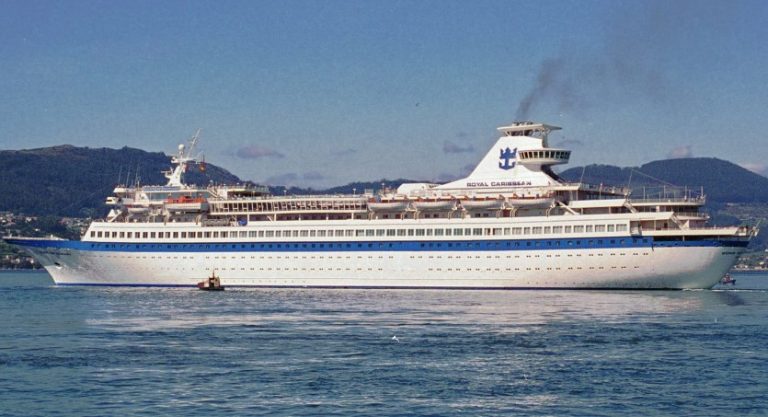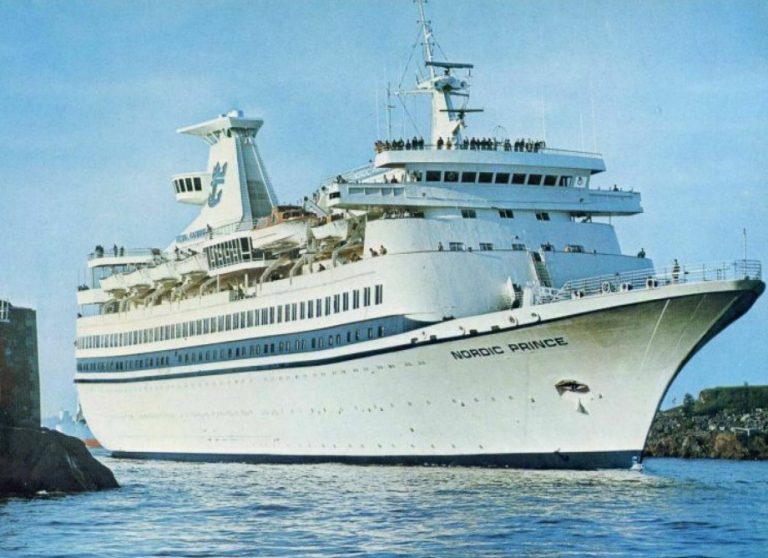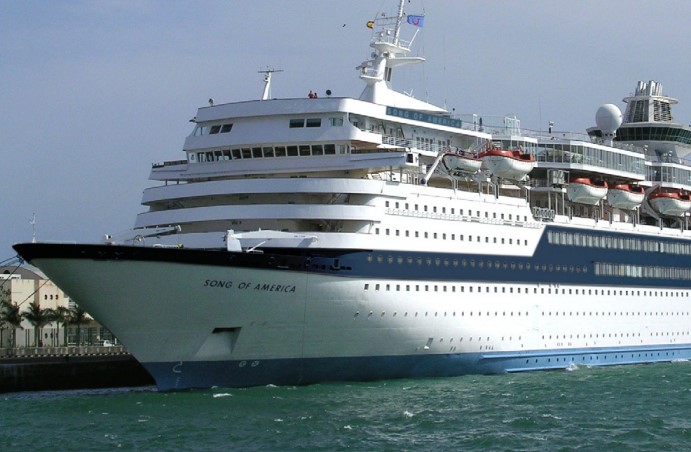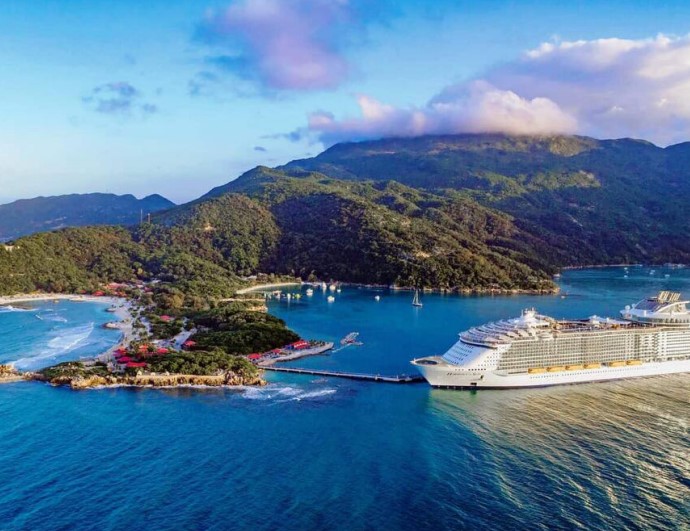Royal Caribbean: the History of the Cruise Giants
Royal Caribbean International, initially known as Royal Caribbean Cruise Lines, was founded in 1968 as a consortium of three Norwegian shipowners who wanted to enter the burgeoning U.S. cruise market. Edwin Stephan had designed a cruise ship specifically for warm seas and presented the plans to Anders Wilhelmsen, I.M. Skaugen and Gotaas Larsen.
On January 31, 1969, Royal Caribbean Cruise Line was born, and soon after, the company ordered its first ship from the Wartsila shipyards, the Song of Norway, which debuted in 1970, followed by Nordic Prince in 1971 and Sun Viking in 1972. In addition to the central pool with the lido and large open spaces, which would become essential features of modern cruise ships, Edwin Stephan conceived the traditional lounge with large windows in the funnel, which, with its spectacular view from above, would become one of the first symbols of the cruise line.
Six years later, Royal Caribbean made the bold decision to lengthen the Song of Norway by 85 feet, increasing its capacity from 725 to 1,040 passengers. The operation was repeated two years later on the Nordic Prince. In 1982, Royal Caribbean aligned itself with the industry trend of building larger ships by launching the Song of America, which at the time was the third-largest passenger ship in the world. It could accommodate just over 1,500 people and was one of the largest ships in the Royal Caribbean fleet. In 1986, the company diversified its investments by leasing a coastal property in Haiti, offered to passengers as a private island called Labadee, an option still available today.
4. Edwin Stephan
0. The Song of Norway
A new fleet expansion occurred in 1988 with the launch of its first Sovereign-class ship. Sovereign of the Seas made history as the first “mega-ship” of the modern cruise era, with a tonnage of 73,000 tons, almost double that of the Song of America and a capacity of up to 2,276 passengers. The ship introduced innovations such as the modern atrium, glass elevators and a piano bar. Also in 1988, the company purchased Little Stirrup Cay, transforming it into the private destination CocoCay and completed the acquisition of Admiral Cruises, a company specializing in short cruises. After extensive refurbishment, the Viking Serenade was put back into service and in 1990, Admiral Cruises launched the Nordic Empress for the Royal Caribbean brand. Subsequently, other Sovereign-class ships were introduced: Monarch of the Seas in 1991 and Majesty of the Seas in 1992, both of which sailed until very recently. In 1993, the company was listed on the New York Stock Exchange.
In the 1990s, Royal Caribbean began designing ships for destinations beyond the Caribbean, an area in which it had specialized, introducing the Legend of the Seas in 1995, the first ship built specifically for worldwide cruises. This ship, part of the Vision class, offered larger cabins, more space per passenger and new common areas. Between 1995 and 1999, the company retired its first ships, replacing them with new Vision-class vessels. In 1997, Royal Caribbean acquired the Celebrity Cruises fleet from Greek shipowner Chandris and renamed in Royal Caribbean International, with the parent company becoming Royal Caribbean Cruises Ltd. In 1999, the “Eagle” project led to the launch of the Voyager of the Seas, which, with innovative features such as an ice-skating rink and a climbing wall, redefined the cruise industry. It was the first time that the maximum passenger capacity exceeded 3,000.
1. Nordic Prince
2. Song of America
In the early 2000s, Royal Caribbean introduced additional Radiance and Vision class ships while also refurbishing and modernizing its existing fleet. In 2006, the Freedom class was launched with the Freedom of the Seas, followed by the Liberty of the Seas in 2007 and the Independence of the Seas in 2008, featuring exciting new amenities like a water park and onboard surfing. The ships continued to grow in size, making Royal Caribbean one of the leading contributors to the trend of progressively larger cruise ships.
In 2009, Royal Caribbean launched the Oasis of the Seas, the largest cruise ship ever built, followed by the Allure of the Seas in 2010, the Harmony of the Seas in 2016 and the Symphony of the Seas in 2018. These ships remain the largest in the world today and have ushered in a new era in the cruise industry that goes beyond just massive size. Some of the features first introduced on the Oasis class have marked a turning point in the mega-ship landscape. For example, the Boardwalk is one of the most striking innovations: an open-air promenade with various venues designed to resemble a Mediterranean village. Balconies from some cabins overlook it on the two longer sides across six decks; the forward-facing wall is glass and separates the area from a large nightclub, and at the stern, there is an open-air amphitheater, the Aqua Theater, dedicated to aquatic shows. Equally notable is the famous Central Park, recreated onboard as a large garden with sophisticated dining options, real plants and an incredibly authentic atmosphere. The Royal Promenade, introduced on the Oasis class, is not entirely new, given its previous appearance on Royal Caribbean’s Voyager class. However, it has evolved in terms of size and modernity, featuring a large commercial area located on three decks just below Central Park, which can also be accessed from an innovative bar that can move vertically from the Royal Promenade to Central Park.
Innovation, creativity and an extensive range of venues have remained the brand’s strengths in new ship classes, emerging after one of the most significant moments of change in cruise ship engineering. Simultaneously, the Quantum class ships were introduced, targeting both the North American and Asian markets. The Quantum of the Seas was the first to launch in 2014, followed by the Anthem of the Seas in 2015, the Ovation of the Seas in 2016, the Spectrum of the Seas in 2019 and the Odyssey of the Seas in 2021.
3. Royal Carribean’s ship in Labadee, Haiti
5. Icon of the seas
Royal Caribbean continues to innovate with the introduction of new ships. In 2024, it launched the Utopia of the Seas, a new Oasis-class ship, alongside the Icon class, which is currently the largest ever built by the company, offering unique experiences such as the largest water park at sea and over 40 restaurants. Recently, Royal Caribbean announced a new order at Meyer Turku for a fourth Icon-class ship for 2027, with options for a fifth and sixth unit. This trend toward growth is noteworthy in the current downturn in shipbuilding compared to the pre-pandemic surge.
These new orders ensure the group’s stability and promise the opportunity to see new solutions within one of the most innovative and cutting-edge fleets in the international cruise industry. The drive for renewal and improvement has characterized all new ships launched by Royal Caribbean, even within the same class of vessels. Edwin Stephan’s legacy extends beyond the success and fame of the brand; it encompasses the evolution of the entire industry, thanks to his futuristic vision and boundless creativity and foresight. He would formally remain in charge until 1996, but in practice, until 2003. The story of Royal Caribbean continues, surprising us every time we step aboard a new ship, and it’s impossible not to use the expression that has become part of Royal Caribbean’s slogans… “Wow”!
Don’t miss more updates, news and reviews about Royal Caribbean International on Cruising Journal.

